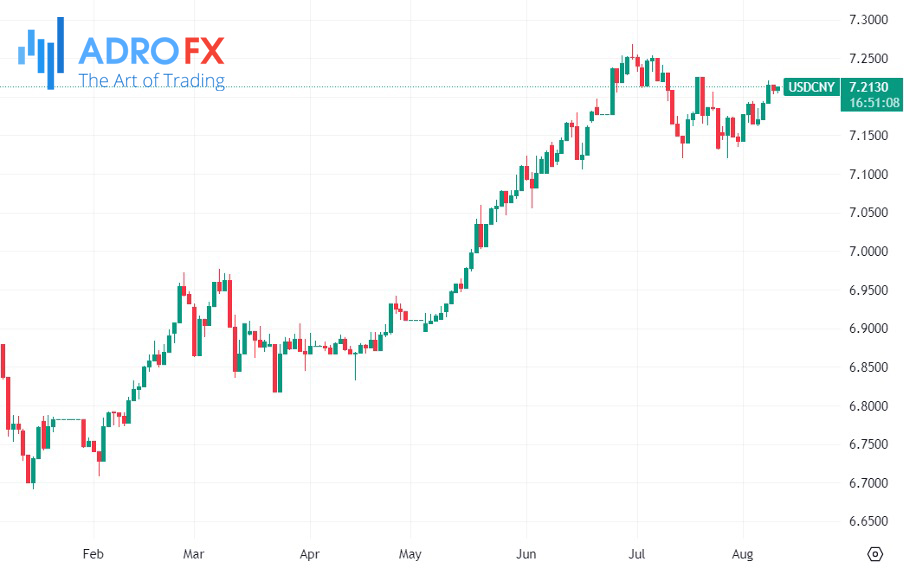Stock Futures Rise Amid Global Influences; Gold Prices Dip in Response to Economic Trends

Key events:
- USA - Core CPI (MoM) (Jul)
- USA - CPI (YoY) (Jul)
- USA - CPI (MoM) (Jul)
- USA - Initial Jobless Claims
Stock futures climbed during overnight trading on Wednesday, building on slight upswings seen in major benchmark indices. Investors were attentively tracking upcoming earnings reports, all the while keeping an eye on a crucial consumer price index announcement that could potentially influence the course of future interest rates.
Dow experienced a decline driven by the ongoing slump in the tech sector, primarily led by a dip in chip stocks. Investors displayed caution in placing bullish bets, particularly in anticipation of Thursday's inflation report.
Specifically, the Dow Jones Industrial Average saw a 0.5% decrease, equivalent to a 191-point drop. Meanwhile, the Nasdaq saw a more substantial 1.2% decline, and the S&P 500 also retreated by 0.7%.

European markets orchestrated a noteworthy recovery yesterday, following the Italian government's elucidation of details surrounding its unexpected windfall tax announcement earlier in the week. This resurgence was also buoyed by the belief that China's deflationary trend might prompt a cessation of additional interest rate hikes by central banks in both Europe and the United States.
Regarding currency performance, the US dollar exhibited robust strength both in yesterday's trading session and on a month-to-date basis. Among the G10 currencies, the euro, Swiss franc (CHF), and Japanese yen (JPY) secured the top three positions after the US dollar. Conversely, the New Zealand dollar (NZD), Australian dollar (AUD), and Canadian dollar (CAD) demonstrated the weakest performance, aligning with the characteristic risk-off pattern prevalent in G10 FX markets.

China's role in driving the risk-off sentiment is particularly noteworthy. Subsequent to lackluster trade data the previous day, yesterday's inflation metrics confirmed China's entry into a deflationary phase. The year-on-year Consumer Price Index (CPI) receded from 0.0% to -0.3%, while the Producer Price Index (PPI) stood at -4.4%. This deflationary scenario finds its roots in subdued domestic demand, notably influenced by ongoing challenges in China's property market. Concerns were further exacerbated by missed bond payments from Country Garden. The recent potency of the US dollar has slightly waned, partially due to a stronger-than-anticipated USD/CNY rate set by the People's Bank of China (PBoC). However, the persistent impact of rate differentials, unseen for over a decade, will continue to exert pressure on the Chinese yuan (CNY).

Within this global context, the US dollar is poised to maintain its robust stance. In the event that risk aversion escalates, particularly in the lead-up to today's release of US Consumer Price Index (CPI) data, a worst-case scenario could involve a CPI reading significantly surpassing expectations, potentially applying additional downward pressure on global equity markets. Nonetheless, it appears unlikely that a substantially stronger CPI figure will materialize, especially considering the nascent onset of rental disinflation.
Gold prices found themselves at a one-month nadir on Thursday. The precious metal had experienced a substantial downturn over the previous week, succumbing to the pressure exerted by a resurgent dollar and escalating yields. Escalating aversion to risk further propelled traders toward the dollar, as investors wagered on the notion that US interest rates would maintain their elevated position for an extended period this year.

The lion's share of gold's recent losses was propelled by the anticipation that the US consumer price index (CPI) inflation would exhibit a marginal increase in July, persisting at a sticky level considerably above the Federal Reserve's target range.
Any indications of persistent inflation provide the Federal Reserve with a heightened incentive to uphold high rates and stringent policies, a circumstance that casts a shadow over non-yielding assets like gold.
The prospect of an elevated CPI reading also bolstered the dollar, establishing it as the preferred sanctuary for safeguarding investments, surpassing the allure of gold. The greenback was trading in proximity to its five-week peak, while 10-year US Treasury yields remained in proximity to their peak for 2023.
In a separate development earlier this week, certain Federal Reserve officials advocated for additional interest rate hikes, citing the tenacious grip of inflation. The central bank had previously indicated the potential for at least one more interest rate increase within the year.

Moreover, the bank is anticipated to sustain higher rates over a prolonged period, a circumstance that dampens the potential for significant upswings in gold's performance throughout the year. Elevated interest rates amplify the opportunity cost associated with investing in gold and similar non-yielding assets.
Other precious metals were similarly grappling with substantial losses for the week. Platinum experienced a nearly 4% decline, while silver underwent a 4.1% drop.









